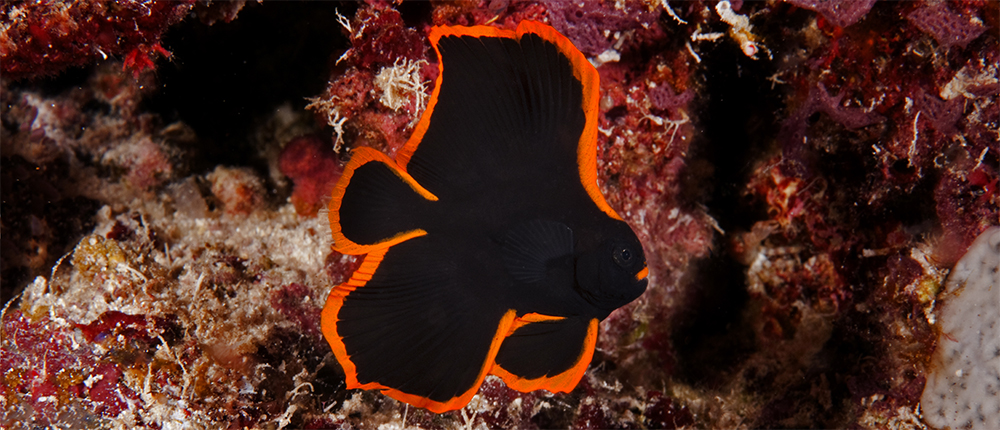Wakatobi’s Imposters
What’s that fish? Are you sure? Fish spotting and identification is a favorite underwater activity for many divers and snorkelers visiting Wakatobi Resort. And thanks to our protected reefs, which teem with several thousand species of fish and even more varieties of invertebrates, there’s no shortage of subject material. Some animals are iconic and easy to find, others are cryptic, elusive and so perfectly camouflaged that finding them requires patience and a very keen eye. And then there are the fakers—creatures that deliberately deceive by taking on the appearance of an entirely different animal. Such ruses are usually undertaken for one of the same two reasons that motivate most behaviors on the reef: to make it easier to eat something, or to avoid being eaten. Let’s meet some of the imposters that practice their deceptive arts on the reefs of Wakatobi.
In bad taste
One of the easiest ways in the ocean realm to avoid being eaten is to look like something most predators would consider unpalatable. The black saddle mimic filefish uses this strategy, taking on the color pattern and morphology of the black saddle toby. Both have white bodies with dark v-shaped saddles, dark speckles and yellow tails. Tobys are members of the puffer family, and deploy chemical defenses in the form of tetradotoxin. This potent neurotoxin, which is 1,000 times stronger than cyanide, is laced in the fish’s skin and other tissues. Most things in the ocean know better than to take a bite of these toxic puffers.
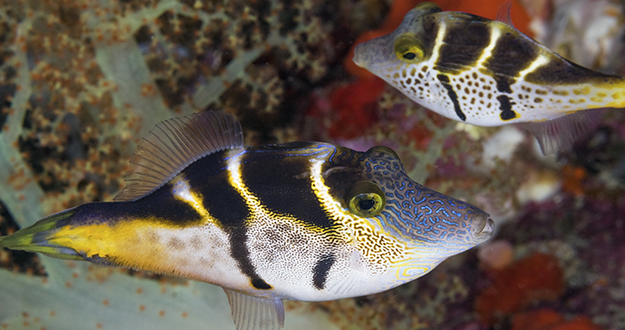
The photographer captured this image thinking both fish were of the same species. Upon closer inspection he realized the fish in the foreground is a mimic filefish, which carries the same markings as the black saddle toby in the background. Photo by Walt Stearns
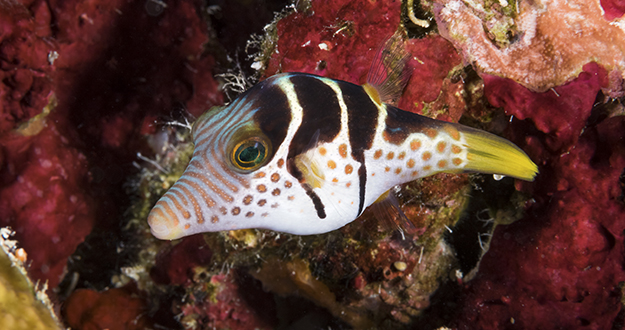
Tobys are a dwarf variety of the puffer family, only growing to a mere 3 inches in size. Photo by Walt Stearns
And not only does the clever filefish take on the look of a toxic puffer, it also hangs around with its lookalike. Look closely at a group of black saddle tobys and you may be able to determine that some show subtle differences such as a more elongated dorsal spine. And if the fish in questions raises that spine, it’s definitely revealing itself to be a filefish. On the other hand, if the fish starts to swell up, it’s obviously a puffer.
Banded brothers
The banded sea krait roams the reefs of Wakatobi with relative impunity, as few predators are willing to risk a nip from this highly-toxic reptile. Meanwhile, most of the region’s snake eels spend the daylight hours hidden in the sand, waiting for the safety of darkness to venture out. But not the banded snake eel. It moves through grass beds and forages on sandy slopes in broad daylight, relying on mistaken identity as its sole means of defense. Key to this misdirection are the eel’s distinctive black and white bands, which are an almost exact match for the banded sea krait. But look closer and you will see some differences. The krait’s body is more rounded, and its head is blunt.
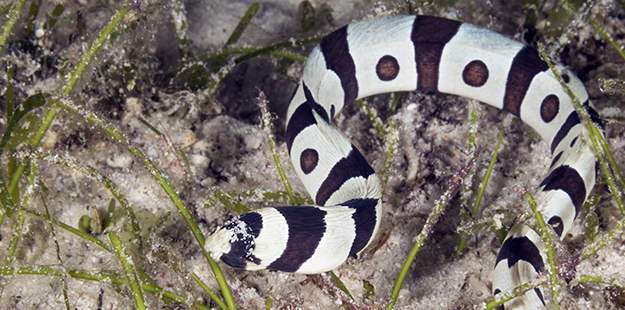
The banded snake eel can easily be mistaken for a sea krait as it moves through the seagrass beds, relying on mistaken identity as its primary defense mechanism. Photo by Walt Stearns
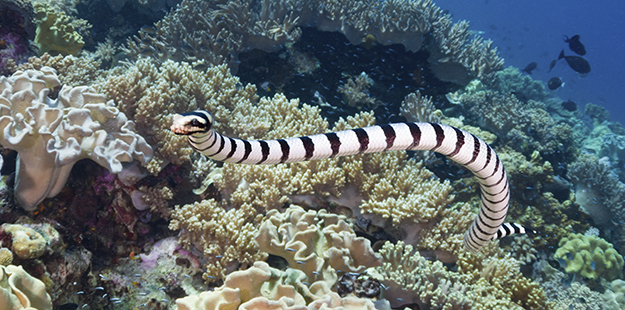
Unlike the snake eel, the sea krait has lungs, and must come up for air every hour or so. Photo by Walt Stearns
By contrast, the eel is taller and thinner in cross section, has a low-profile dorsal fin that continues the banded coloration, and sports a pointed head with a pair of large downward-facing nostrils on the upper jaw, which also angles downwards. These nostrils give the eel an excellent sense of smell, helping to sniff out prey hidden beneath a sand or muck bottom. Another feature you’ll notice on the krait is the vertically-flattened tail, which helps the snake swim, and actually makes it more comfortable moving through the water than slithering on land. Unlike the eel, which has gills, the krait has lungs, and must come up for air every hour or so. Both of theses animals can be fascinating to watch as they go on the hunt. And as long as you don’t openly harass and handle a krait, you are in very little danger of a nip.
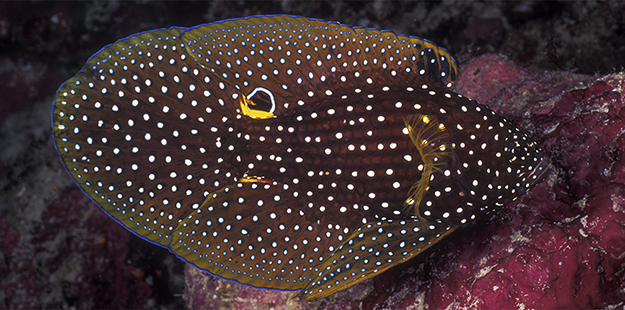
The comet sports a distinctive eyespot at the base of its dorsal fin, but the fish’s real eyes blend in with the body coloration. Photo by Wakatobi Resort
Turning tail
If a marine beta fish is not moving, it can be hard to tell which end you are facing. Also known as the comet, this mid-sized reef dweller is almost symmetrical in profile. Its body is covered in a distinctive pattern of tiny white to pale-blue dots, and it sports a single, distinctive eyespot at the base of the dorsal fin. Meanwhile, the fish’s real eyes blend in with the body coloration. Eyespots are used by a number of species to misdirect would-be attackers. The strategy is to cause the attacker to misjudge the direction their prey will flee, based on the assumption that the spot is an actual eye at the front end of the fish. The comet takes the ruse one step farther, using its eyespot as a hunting aid. When a small fish or crustacean is spotted, the comet will move in sideways until the target darts away. As often as not, the prey will guess wrong, and move in the direction of the comet’s waiting mouth. You probably won’t see this strategy during the day at Wakatobi, as comets spend the sunlit hours hiding in crevices and under ledges.
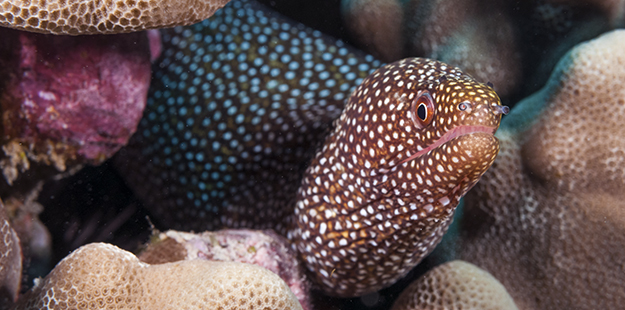
When the comet feels threatened and ducks into the reef head first, it’s hind end bears a remarkable resemblance to a white-spotted moray eel peeking out of a crevice. Photo by Walt Stearns
When comets do come out to hunt in the evening, a comet has one more trick in the bag. If threatened, it will duck into the reef head first, leaving its tail and eyespot exposed. In this position, the comet’s hind end bears a remarkable resemblance to a white-spotted moray eel poking its head out of a crevice.


